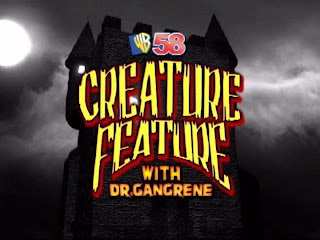A couple of days ago my friend Tim Lucas (film critic, writer, former editor of Video Watchdog magazine) posted a photo on Facebook from The Frozen Dead (1966). I’ve been aware of this movie for some time now and always meant to watch it but somehow never got around to it. Which is surprising because subject matter-wise it’s right up my alley. So, I thought I’d do myself a favor and finally seek this one out.The Frozen Dead stars Dana Andrews as a Nazi mad scientist named Dr. Norberg, speaking with a German inflection no less! I’ve always liked Dana Andrews, so that was a plus for me right off the bat. The plot is suitably ridiculous for this type of film: Norberg is attempting to revive a squadron of Nazi soldiers that have been frozen since WWII, and in the process, has been carrying out wild experiments, which include a wall of severed arms kept “alive.”
He maintains a hidden room full of botched experiments—soldiers that were faultily resurrected as brain-dead zombies. The doctor’s niece unexpectedly arrives for a visit with a friend named Elsa (Kathleen Breck). Their stay doesn't go as well as expected, however, as one of the resurrected soldiers murders Elsa on their first night at the mansion.

(Gotta love that the frozen soldiers are held by clamps on their HEADS, like frozen chunks of beef.)
Not one to let an opportunity go to waste, Norberg uses this as an excuse to perform an experiment he'd always wanted to try. He keeps Elsa’s severed head alive in a box, with a plastic dome mounted over the top of her skull where the brain is now exposed. Her skin is also inexplicably blue.

While I appreciate the mad science shenanigans in this one, it’s unfortunately nowhere near as interesting as it could have been. The setup is great, but the film falls short in the execution; large portions of this one are just plain boring. The film also lifts heavily from the much better film The Brain that Wouldn’t Die (1962). Just as in that film, this one has a female head kept alive through science, a failed experiment locked away (the monster in Brain, the zombie soldiers in this one), and the head develops telepathic powers in each. Elsa begs for them to "Bury me," and in Brain we hear the woman (Jan, played by Virginia Leith) beg, "Let me die." By the way, The Brain that Wouldn't Die in turn borrowed material from the German film The Head (1959), which brings us back full circle with the Germanic influence.
The Frozen Dead was directed by Herbert J. Leder, who also directed It! starring Roddy McDowall. In fact, this film played on a double bill with It!. Leder had also previously written the screenplay for Fiend Without a Face.
Despite the pacing issues, The Frozen Dead is still worth a watch with plenty of outlandish elements, including zombies, frozen Nazi soldiers, gruesome experiments, a dungeon laboratory, severed body parts, and a head kept alive. Plus, it's got some memorable visuals. If you're a sucker for mad science films like me, then check it out!


.jpeg)



















.jpeg)




